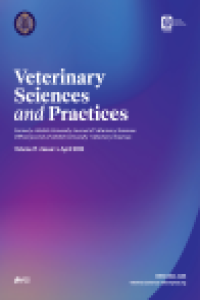Ülkemizdeki Deniz Memelileri Gösteri Merkezlerinin Durumu
Bu çalışmada ülkemizdeki deniz memelileri gösteri ve terapi merkezlerinin durum tespiti ve bu merkezlerdeki memelilerin yaşam şartlarının belirlenmesi amaçlanmıştır. Bu amaçla 2007 yılı itibariyle gösteri ve terapi merkezlerinin bulunduğu Aydın-Kuşadası, Muğla- Bodrum ve Marmaris, Antalya, Kaş, Kemer-Beldibi, Serik’teki merkezler incelenmiştir. Deniz memelilerinin yaş, boy, ağırlık, cinsiyet, beslenme, yaşam ortamları, sağlık koşulları gibi parametreleri belirlenmiştir. Tesislerde gösteri amaçlı ithal edilmiş toplam 12 adet yunus, 6 adet fok, 3 adet beyaz balina, 1 adet deniz aslanı ve 1 adet mors olduğu belirlenmiştir. Tespit edilen 35 adet yunustan 25 adetinin özellikleri incelenmiş, % 28’i dişi % 72’si erkek bireylerden, ortalama yaşlarının 12.26 ve ortalama ağırlıklarının da 170 kg olduğu hesaplanmıştır. Günlük yem tüketimlerinin yunuslar ve foklarda yaz aylarında 8 kg, kış aylarında 12 kg, deniz aslanının ve morsun ise 20 kg olduğu belirlenmiştir. Tesislerde çalışan personelin neredeyse tamamı yabancı uyruklulardan oluşmaktadır. Bunlardan çoğu (% 85) Rusya ve Ukrayna kökenli olduğu belirlenmiştir. Araştırma boyunca incelenen tesislerden sadece Marmaris’teki tesisin tamamen zihinsel ve bedensel engelliler terapisini sağlamak üzere kurulduğu tespit edilmiştir. Diğer tesislerin ise genel olarak şov amaçlı fakat ilave olarak zihinsel ve bedensel engellilere hizmet verme amacıyla kurulmuş olduğu belirlenmiştir.
Anahtar Kelimeler:
Deniz memelileri, Gösteri merkezleri, Terapi merkezleri
___
- Anonim, 1973. Convention on International Trade in Endangered Species of Wild Fauna and Flora. USA.
- Anonim, 1979. Bern Convention on the Conservation of European Wildlife and Natural Habitats.
- Aydın M., Gündoğdu M., Yahşi RS., 2008. Ülkemizde Yunus Yakalanması ve Kullanımı. Tarım ve Köy İşleri Bakanlığı, Koruma ve Kontrol Genel Müdürlüğü, Teknik Rapor. s: 16. Bengil F., Kankuş J., Sönmez R., Danyer E., Sevim M., Tamtürk Z., 2010. Havuz Tutsakları “Yunuslar”. Sualtı Araştırmaları Derneği, Deniz Memelileri Araştırma Grubu. Rapor. s: 53.
- Birch S., 1995. “EEG measurements taken as putative indicators of hormonal expression in vivo”. Prince Henry’s Institute of Medical Research, 3rd Annual Scientific Symposium. Hormones and the Brain.
- Birch S., 1997. Dolphin-human interaction effects. Doctor Thesis at Dept. of Electrical & Computer Systems Engineering, Monash University, Caulfield Campus.
- Birch S., 1998. Dolphin sonar pulse intervals and human resonance characteristics. Bio electromagnetism, Proceedings of the 2nd International Conference 141-142. DOI: 10.1109/ICBEM.1998.666435
- Brakes P., Williamson C., 2007. Dolphin Assisted Therapy: can you put your faith in DAT? Whale and Dolphin Conservation Society. s: 21.
- Cole DM., 1996. Phenomenological effect of dolphin interaction on humans. International Symposium on Dolphin Healing. Co-hosted by the Aqua Thought Foundation. 1-7.
- Heimlich K., 2001. Animal-assisted therapy and the severely disabled child: a quantitative study. J. Re habil. 67.
- Lukina LN., 1999. Influence of dolphin-assisted therapy sessions on the functional state of children with psychoneurological symptoms of diseases. Human Physiology, 6, 676-679.
- Lysenko VI., Zagoruichenko IV., Batozsky JK., 2000. The usage of the dolphin therapy in the rehabilitation of children .Material of the 6-th Congress of Pediatricians of Russia «Urgent states of children». Moscow, 177-178.
- Marino L., Lilienfeld OS., 2007. Dolphin assisted therapy: More flawed data and more flawed conclusions, Anthrozoös, 3, 239 – 249.
- Nathanson DE., 1989. Using Atlantic bottlenose dolphins to increase cognition of mentally retarded children. In: Lovibond, P. and Wilson, P. (eds.). Clinical and Abnormal Psychology. Elsevier Science Publishers, North Holland, 223-242.
- Nathanson DE., Faria S., 1993. Cognitive improvement of children in water whit and without dolphins. Anthrozoos, 1, 17–29.
- Nathanson DE., Castro D., Friend H., McMahon M., 1997. Effectiveness of short-term dolphin-assisted therapy for children with severe disabilities. Anthrozoos, 10, 90-100.
- Smith BA., 1981. Using dolphins to elicit communication from a autistic child. School of Public Affairs and Services, Library at Dolphins Plus, Florida. s: 154. Voorhees R., 1995. The effect of a unique stimulus (swimming with dolphins). On the communication between parents and their children with disabilities. Masterwork. University of Miami, School of Medicine.
- Başlangıç: 2022
- Yayıncı: Atatürk Üniversitesi
Sayıdaki Diğer Makaleler
Kıvırcık Koyunlarında Koroner Arterler Üzerine Makroanatomik bir Çalışma
Ülkemizdeki Deniz Memelileri Gösteri Merkezlerinin Durumu
Mehmet AYDIN, Uğur Yücel KESİCİ
Hurrem AKKOYUN, Nursel DOSTBİL
Hiperisin’in İzole Edilmiş Sıçan Midesinde Mide Asit Sekresyonu Üzerine Etkisi
Kısraklarda Erken Gebelik Tespiti
Mehmet ATLI, Mehmet KÖSE, Ercan KURAR, Aydın GÜZELOGLU, Ahmet SEMACAN
Emre OZAN, Hatice Mahur TURAN, Harun ALBAYRAK, Abdullah CAVUNT
Bir Koyunda Sekonder Abdominal Gebelik
Hayrettin ÇETİN, Ömer KORKMAZ, Mehmet ATLI
